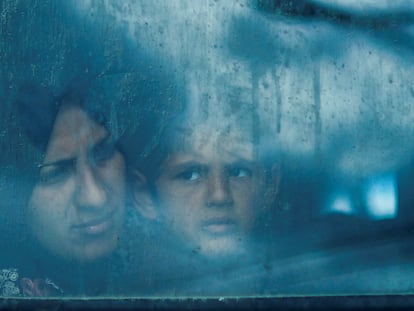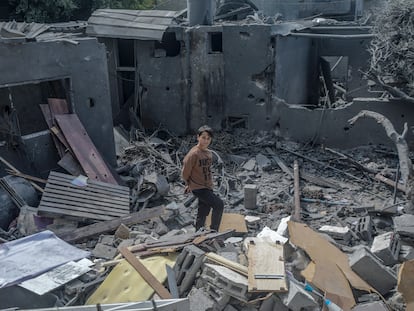Harassment and smear campaign jeopardizes the work of the UN agency for Palestinians
Health, education and garbage collection in the camps for displaced people depend directly on UNRWA, which is being targeted by Israel

A group of workers collects garbage as students play in a school yard next to a health center that helps mostly women and children. This daily scene in the Aida camp in the West Bank would not be possible without the United Nations agency for Palestinian refugees (UNRWA). “Everything in this health center, from the cleaner to the head doctor, are employees [of the agency]. The same goes for the educational system. The guard, the cleaner, the second grade teacher, the eighth grade teacher… They are all our staff,” explains Adam Bouloukos, the UNRWA director in the West Bank, during a visit to Aida in late February. The UNRWA — which was born nearly 75 years ago and serves almost six million refugees — is of the utmost importance, according to Bouloukos. But amid the war in Gaza, Israel is attempting to discredit the work of the U.N. agency.
For weeks, this agency, which operates in Palestine — East Jerusalem, the West Bank, Gaza — and in Lebanon, Syria and Jordan, has been in the eye of the storm, accused by Israel of being part of the Hamas terrorist network. As a consequence of this campaign, 16 donor countries suspended funding at a critical junction of the Israeli offensive, sparked after the Hamas attacks on October 7. More than €400 million ($437 million) have been frozen, which jeopardizes an institution that is the main source of income for the 2.3 million inhabitants of Gaza. Spain announced an extraordinary donation of €20 million ($22 million) on Thursday, and Canada and Sweden reported on Saturday that they would resume funding to the agency.
The United Nations has opened an investigation, while UNRWA defends itself against Israel’s accusations and accuses Israel of torturing its employees to force false testimonies. Israel first targeted 12 of UNRWA’s 33,000 workers, who were expelled from the agency. Later, it raised the number allegedly involved in Palestinian Islamist groups to 450. The head of the agency, Philippe Lazzarini, says that he has received no evidence of this.
“It is not just Gaza that is affected by the accusations against the 12 employees, it is the entire organization,” says Bouloukos, who describes how Israel’s attack and the reduction in donations has had a flow-on effect beyond Gaza.
“Conflict and occupation are part of everyone’s lives, no matter what you do or where you are in the West Bank. There is no Palestinian who is not affected in some way by the occupation,” he says. Israel cannot expect UNRWA to control each of its 33,000 workers, 3,700 of whom are in the West Bank and 13,000 in Gaza, he adds. All of them, according to Bouloukos, continue to receive their salaries on time despite the economic collapse, something that many officials in the Palestinian administration cannot say. Meanwhile, in the Gaza Strip alone, 150 UNRWA employees have died in the current war and 3,000 have been left homeless. “We have a policy of zero tolerance for violations of neutrality, but we do not have a zero-risk environment,” says the UNRWA director in the West Bank.
Military objective
UNRWA workers are subject to almost systematic “harassment” due to the war in Gaza, says Bouloukos, who recalls the case of two employees who were recently stopped by Israeli soldiers on a West Bank road while the troops shouted “UNRWA, Hamas! UNRWA, Hamas!” “They arrested them, took them out of the car, handcuffed them, threw them on the ground blindfolded and beat them,” says Bouloukos, who regrets that the agency is a direct “target” of the Israeli military.
This is just one of sign of how violence has escalated in the West Bank as a result of the war in Gaza, with the number of West Bankers killed reaching a record high in 2023: more than 500, triple the figure of 2022, says Bouloukos.
Many of the 12,000 raids carried out last year by the Israeli Defense Forces (IDF) in the West Bank — where it “has access to every last corner” — took place in refugee camps. According to Bouloukos, at the height of the war, the IDF launched a “new strategy” to raze refugee camp infrastructure, housing, roads, streets and sanitation. If a single person was arrested in a multistory home, the entire residence for 50 or 60 people is often destroyed. “Like an earthquake,” he explains.
This has been the IDF’s strategy since October 7 and Israeli settlers are also part of it, says Bouloukos, referring to the most violent Jews of the half million who live in Palestinian territory. He estimates that around 4,000 people from 1,000 families have been displaced from their place of residence and that 10,000 Palestinian-owned olive trees were destroyed. This is not only a “tragedy” for the economy, but also for the Palestinian way of life, which is tightly linked to this crop.
Making matters worse was Israel’s decision to deny work permits to the more than 200,000 people in the West Bank in retaliation for the war. “You have a young male population unemployed, with no money in their pockets and nothing to do. This is a bad recipe, isn’t it?” says Bouloukos, who adds that there have been attacks on shops and robberies as a result of the economic strain.
The more than 8,000 inhabitants of the Aida camp are descendants of the 2,500 people who were expelled from their towns in historic Palestine and resettled in tents on this small plot of land on the outskirts of Bethlehem — a move that coincided with the founding of the State of Israel in 1948. Over the years, population density has skyrocketed above 100,000 inhabitants per square kilometer. At the exit of the health facilities, Duaa, 30, and her son, Mohamed, three, represent the new generations of refugees who are settling in the same territory, anchored by the desire to return to the place their ancestors were expelled from.
Indeed, the entrance arch to the refugee camp is a large lock crowned by a key several meters long — it’s a reminder of everyone’s dream to return to the land of their ancestors. Meanwhile, these displaced persons camps — which grow in the allocated space without any urbanization plan — are trying to deal with common problems such as securing drinking water and sanitation amid a poverty rate that is higher than other places in Palestine. Some 300,000 refugees, about a third of all those living in the West Bank, live in 19 camps. Thanks to the UNRWA, 46,000 children are in school in the West Bank alone.
“We are not responsible for managing the camp, the UNRWA only provides services,” clarifies Amjad Abu Laban, one of the agency’s employees in Aida. Over the years, these refugee camps have continued to face difficulties, not only due to the low quality of life, but also due to the violence of the occupation. Aida, with soldiers stationed a few meters away, is one of the places that is most frequently raided by Israeli troops.
Aida, one of 19 refugee camps in the West Bank, occupies 70,000 square meters, the equivalent of about seven football fields. Over the years, the canvas tents were replaced by brick and, once homes could add stories, they built up in a disorderly and uncontrolled manner. “No one” supervises the works, admits Laban, at the foot of a house, where a floor is being added.
Vehicles cannot fit through many of the narrow streets, making evacuating people difficult. Laban doesn’t even want to think about what would happen in a fire or an earthquake. A ten-meter concrete wall built by Israel divides neighbors and separates Aida from the domain of the city of Jerusalem. From the roof of the health center, built in 2020 by UNRWA, the houses of different Jewish settlements — considered illegal by international community — can be seen from behind the fortress.
At street level, dozens of children rush out of school with their backpacks bouncing up and down on their backs. They pass in front of the mural painted on a wall with the face of a teenager, who was shot dead by Israeli soldiers last November.
Sign up for our weekly newsletter to get more English-language news coverage from EL PAÍS USA Edition
Tu suscripción se está usando en otro dispositivo
¿Quieres añadir otro usuario a tu suscripción?
Si continúas leyendo en este dispositivo, no se podrá leer en el otro.
FlechaTu suscripción se está usando en otro dispositivo y solo puedes acceder a EL PAÍS desde un dispositivo a la vez.
Si quieres compartir tu cuenta, cambia tu suscripción a la modalidad Premium, así podrás añadir otro usuario. Cada uno accederá con su propia cuenta de email, lo que os permitirá personalizar vuestra experiencia en EL PAÍS.
¿Tienes una suscripción de empresa? Accede aquí para contratar más cuentas.
En el caso de no saber quién está usando tu cuenta, te recomendamos cambiar tu contraseña aquí.
Si decides continuar compartiendo tu cuenta, este mensaje se mostrará en tu dispositivo y en el de la otra persona que está usando tu cuenta de forma indefinida, afectando a tu experiencia de lectura. Puedes consultar aquí los términos y condiciones de la suscripción digital.
More information
Archived In
Últimas noticias
Most viewed
- David King, chemist: ‘There are scientists studying how to cool the planet; nobody should stop these experiments from happening’
- Reinhard Genzel, Nobel laureate in physics: ‘One-minute videos will never give you the truth’
- Mexico completes its trade shift with the entry into force of tariffs on China and countries without trade agreements
- Oona Chaplin: ‘I told James Cameron that I was living in a treehouse and starting a permaculture project with a friend’
- Sinaloa Cartel war is taking its toll on Los Chapitos










































